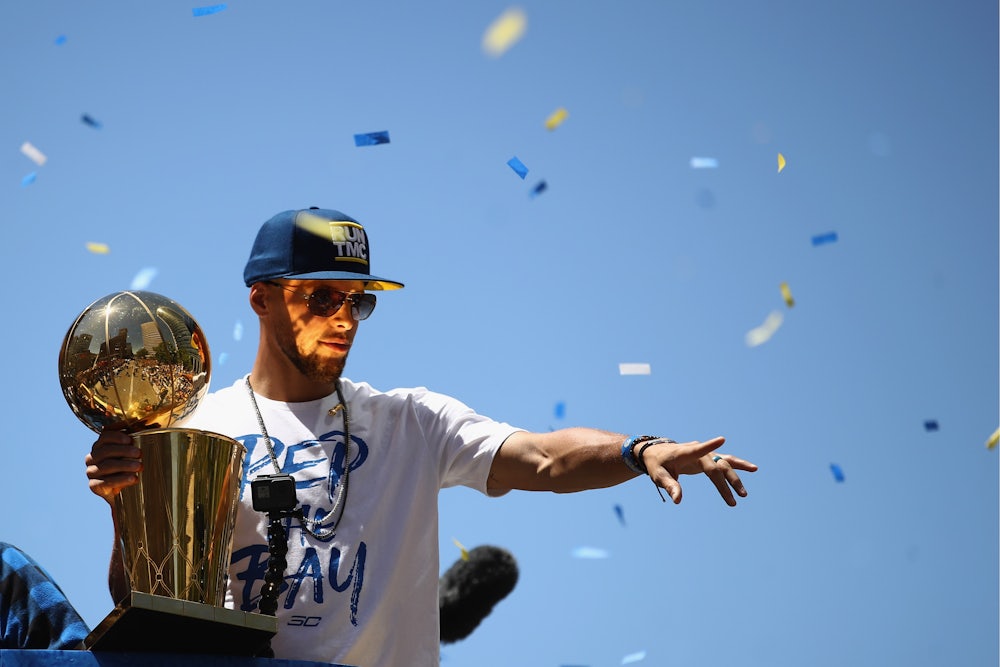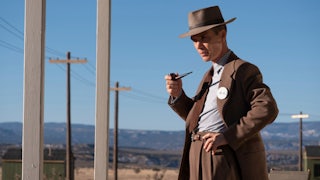At the beginning of Underrated, from Apple Original Films, director Peter Nicks hands former NBA player Reggie Miller another Apple product, an iPad. Miller begins reading from the device:
Far below NBA standard in regard to explosiveness and athleticism. At 6–2, he’s extremely small for the NBA shooting guard position. Do not rely on him to run your team. Can overshoot and rush into shots. Doesn’t like when defenses are too physical with him. Not a great finisher around the basket due to his size and physical attributes. Needs to add some muscle to his upper body, but appears as though he’ll always be skinny.
Miller looks up at the camera. “That,” he announces incredulously, “was the draft report on Stephen Curry.”
Well, it was half of it. Scouting reports have two sections, listing strengths and weaknesses. Miller read from the latter. The same report, if you look it up, also states Curry “can get any shot he wants and has great shot efficiency,” but this is the kind of early praise for its star that Underrated has to jettison if it wants to stay true to its name. Nicks’s film chooses instead to highlight Curry’s preferred narrative about himself: a scrawny, undersized kid passed over by nearly every Division I college basketball team only to one day become a four-time NBA Champion and two-time MVP.
This version of Steph Curry tends to, well, underrate reality. The notion that Curry remains an underdog is humorous to contemplate when you consider that his production company (which made the film in conjunction with A24 and Apple) is called Unanimous, so named for the fact that Curry is the only player in the history of the NBA to have received a unanimous vote for the MVP Award (for the 2015–16 season). The documentary opens on the night of December 14, 2021, when Curry beats the all-time record for three-point shots made. He drinks wine with his teammates while wearing a cap emblazoned with 2,974, an astronomical figure, but one Curry was by then well expected to hit.
Underrated is not the first documentary Curry’s Unanimous Media has made about its proprietor: In 2019, the company produced a six-part docuseries for Facebook Watch titled Stephen vs The Game. An athlete making not one, but two documentaries about himself, and with the blessing of prestige indie cinema darling A24, should raise more eyebrows than Underrated has. But these projects come amid a wave of sports media that has cut out the off-the-court referees: journalists. Audiences are now habituated to seeing league-produced documentaries, primarily on streaming services looking to break into reality programming (a way to cut out their own middlemen, writers), including Formula 1’s Formula 1: Drive to Survive, the ATP and WTA co-produced tennis doc Break Point, the NFL’s Quarterback (all on Netflix), and Legacy: The True Story of the LA Lakers (on Hulu), to name just a handful. Players are also getting in on the action. Tom Brady was the executive producer of Man in the Arena: Tom Brady in 2021, and in 2022 Derek Jeter put out The Captain, a series about his career, via The Players’ Tribune—a website of sports writing by athletes that he founded in 2014.
Sean Gregory, writing in Time magazine, has attributed the rise of league-produced, and now athlete-produced, documentaries to the popularity of Michael Tollin’s 2020 series The Last Dance, which followed Michael Jordan and the Chicago Bulls on their 1998 quest to win a third championship in a row (for the second time). Yet The Last Dance did not originate with Jordan (though two of his business associates signed on as executive producers), and its major theme was larger than Jordan himself. It examined the psychology of competition and the way athletes loom large in one another’s imaginations, as Tollin showed, for instance, how Jordan would often invent slights or imagine episodes of disrespect in order to motivate himself in games. This is something that Underrated and much of the recent spate of athlete-produced content miss. These documentaries seek instead to reclaim the narrative from sports journalists; they cast the media—rather than other players—as the primary competition. The result are films that might score points, but lose at telling us something about the game itself.
Underrated slices between the late aughts, when Curry was playing for Davidson College, a small liberal arts school that had not won an NCAA tournament game in almost 40 years, and the 2021–22 season, just as Curry’s team, the Golden State Warriors, hit a rough patch. Beset by injuries, the once seemingly unstoppable Warriors (they won the championship in 2015, 2017, and 2018) finished the 2019–20 season with the worst record in the NBA. Nicks shows Curry driving down the highway as snippets from sports commentators play as if from the radio (though the voices are recognizable from television). Curry takes in the chorus of naysayers while chugging a bottle of Oxigen, his brand of “oxygenated” water. “If Steph isn’t going to be MVP Steph,” the voice warns of the 2021–22 season, “I don’t think the Warriors are legitimate contenders.”
The documentary portrays Curry’s career up to this point as a consistent battle against the odds. We’re shown Curry, aged nine, playing for a 10-and-under basketball team called the Charlotte Stars. Curry is slight and shorter than his teammates, a fact that threatened his confidence at the time, but bolsters his narrative in the present. “That was when I first really understood,” he recalls, “I’m different.” Curry reflects on this moment like a fork in the road. “The temptation,” he explains, “was to think about what I couldn’t do.” It was a test, and he, as we know, passed.
The young Curry, trained by his father, former NBA player Dell Curry, smiles at the camera and says: “I knew I could shoot. That was part of what I brought to the team.” Nicks plays footage of a wee Curry relying on long-range shooting to avoid contact with the bigger players, taking aim from such a distance that the defenders do not even think to defend at the spot. The moment recalls the lesson of the 2019 film Jump Shot: The Kenny Sailors Story, also a Unanimous Media production. Sailors was said to have invented the jump shot so that he could shoot over his much taller brother.
Despite his obvious talent for shooting, Curry fails to be recruited by his first-choice school, Virginia Tech. In fact, he is only recruited by one school, Davidson College. Text flashes across the screen, expressing the direness of the situation: “Davidson College is a liberal arts school of less than 2,000 students just outside of Charlotte, North Carolina.” His friends from high school have never heard of it, souring the moment. The disappointment makes his success there all the more dramatic. In his junior year, Curry leads Davidson on a surprising NCAA tournament run, causing upset after upset. “Davidson’s not supposed to beat Georgetown,” a correspondent remarks on a local news station, just before Davidson beats Georgetown. Nicks includes a clip of Mike Krzyzewski, former coach of the Duke men’s basketball team, telling Charlie Rose during March Madness: “one of the great stories in college basketball is Curry at Davidson.” Rose and Krzyzewski hash out the now familiar notes of the Curry narrative, that he had not been recruited by anyone else, that Krzyzewski had him at the Duke basketball camp and passed. Krzyzewski smiles and holds out his hand to mark Curry’s height, “He was about five-six,” he jokes.
The film fast-forwards to 2022. We hear the voice of sports commentator Skip Bayless ask: “Is Steph tall enough? Strong enough? Defensive enough?” We hear another journalist insist: “This Warriors team’s not winning more playoff games. It is impossible for me to believe.” The media becomes a Greek chorus, oracles of doom. Their doubts are, of course, the same ones that hounded Curry before he was drafted into the NBA. In Stephen vs The Game, an ESPN reporter predicts he will be “a first-round draft pick,” before listing other players who have “far more talent and upside”; and what if he’s not on “the right team”? Certainly, the draft is stressful, but his situation was nothing like, say, that of NFL quarterback Tom Brady, who was picked 199th in the sixth round by the New England Patriots. Still, reality is an afterthought both here and in Underrated. In the world of sports, whatever narrative can motivate you to cross the finish line is the one you go with, and Curry has chosen this one. “That feeling of being overlooked or underrated will always be part of the drive that keeps me going,” he tells the camera in Underrated.
Even his greatest accomplishment is tinged with this sense of overcoming the doubters. At Curry’s celebration party in New York City, shortly after his record-breaking three-point shot against the Knicks, his former teammate Kevin Durant walks over and embraces him. “Remember the time you thought I was a little white kid?” Curry (who is a light-skinned African American) asks Durant, laughing. Durant says he does, and adds: “I mean, who knew this shit 10 years ago. Now you that guy.” Curry’s fair appearance, and the privileges it might have afforded him in dealing with the media or attracting sponsors, are never probed in Underrated. Instead, it exists, baked into this strange exchange, as one of many examples to be introduced over the course of the film of how people saw Curry as an outsider, as someone who did not belong.
If you are a Golden State Warriors fan, you might cheer on this delusion. There are times when the underdog narrative works beautifully in the film, furnishing an opportunity for Curry to shine a light on his coach and teammates at Davidson. “I think about what J-Rich and Thomas and Max and Boris all meant to, like, me and my confidence as a player,” he tells the camera, adding: “You don’t do anything in this life by yourself.” It is a moving message, one that encourages the values of teamwork and shared responsibility that endear so many of us to the world of sports.
Yet, one cannot help but feel, as we watch this bona fide winner, who benefited from a childhood of privilege (not to mention private lessons from his father, a former NBA player), refuse to see himself as such, that the film empties underdog of all meaning, disconnecting it from the legitimate and real forces that might work against a person—or even a whole city.
The film pays scant attention to the Warriors’ relocation from the East Bay and Oakland to the San Francisco waterfront—a move roundly criticized as a blatant effort to court a wealthier and whiter fan base. Perhaps to do so might raise the uncomfortable truth that Curry, regardless of a few negative sound bites from ESPN commentators, is not actually on the losing side of things, but is a winner—in every way our society defines one. What animates Curry’s obsession with underdog status? Is it something in the Silicon Valley air—this need to define one’s success as unlikely, one’s origins as humble, one’s operation as “lean”? These are the kinds of questions a journalist or independent documentarian might ask. No wonder then, that so many athlete-produced films seek to leave those voices on the cutting room floor.






